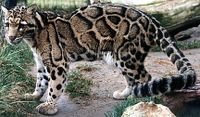Clouded Leopards: Two Species
Posted by: Loren Coleman on December 15th, 2006

A Clouded Leopard, but which species? (Image: Wikipedia).
Hiding in plain sight? It has been discovered, through genetic analysis and other factors, that there is a strong case for the clouded leopard to be divided into two separate species. Presently the clouded leopard is regarded as a monotypic genus with four subspecies.
According to the blogsite Big Cat Rescue, there is good reasoning behind the "reclassification and the defining of two distinct species of clouded leopard – Neofelis nebulosa (mainland Asia) and Neofelis diardi (Indonesian archipelago). This case for two clouded leopard species based on genetic distinction that is equivalent to, or greater than, comparable measures among other Panthera species (lion, tiger, leopard, jaguar, and snow leopard) is also strongly supported by the geographical variation revealed by morphometric analyses of the pelage (coat colour and patterns) between clouded leopard in Mainland Asia and in Indonesia (Borneo and Sumatra); again providing a compelling case for reclassification into two distinct species N. nebulosa and N. diardi.
For the complete discussion and journal abstracts, please see "Research shows clouded leopards are two distinct species".
Cryptozoologically speaking, we wonder if the Formosan clouded leopard still roams. This cat is thought to be extinct in Taiwan, as the last sighting was in 1983 of a snarled juvenile. This subspecies was characterized by its relatively much shorter tail, and historically found below 2500 feet. The hope is that some may have adapted to living above this height on the wilder mountains on Taiwan, and it might not be extinct.

Clouded Leopard stamp issue, India, and thus Neofelis nebulosa.
About Loren Coleman
Loren Coleman is one of the world’s leading cryptozoologists, some say “the” leading living cryptozoologist. Certainly, he is acknowledged as the current living American researcher and writer who has most popularized cryptozoology in the late 20th and early 21st centuries.
Starting his fieldwork and investigations in 1960, after traveling and trekking extensively in pursuit of cryptozoological mysteries, Coleman began writing to share his experiences in 1969. An honorary member of Ivan T. Sanderson’s Society for the Investigation of the Unexplained in the 1970s, Coleman has been bestowed with similar honorary memberships of the North Idaho College Cryptozoology Club in 1983, and in subsequent years, that of the British Columbia Scientific Cryptozoology Club, CryptoSafari International, and other international organizations. He was also a Life Member and Benefactor of the International Society of Cryptozoology (now-defunct).
Loren Coleman’s daily blog, as a member of the Cryptomundo Team, served as an ongoing avenue of communication for the ever-growing body of cryptozoo news from 2005 through 2013. He returned as an infrequent contributor beginning Halloween week of 2015.
Coleman is the founder in 2003, and current director of the International Cryptozoology Museum in Portland, Maine.










God, what gorgeous animals!
Clouded leopards. The “modern-day saber-tooth cat”. All the subspecies have at least one thing in common: they have the longest canine teeth, relative to body & skull size, of any living cats, and in fact it was at one time thought that they might be living members of the extinct genus Paramachairodus, an early saber-tooth. (That theory has been disproven since more fossils have been discovered and fully examined).
Clouded leopards are among the most beautiful of cats. They have many primitive characteristics including a relatively long body and short legs, and a longer, narrower skull than most cats. Early cats probably looked a lot like clouded leopards.
Melanistic clouded leopards occur with some frequency. Clouded leopards are so secretive that they are very seldom seen in the wild, even by native people. They are native to southeastern Asia and Indonesia. I wonder if some of the “big cat” sightings that occur in Australia and New Zealand are clouded leopards that have expanded their range from Indonesia southward, or were maybe even there all along, undiscovered. I don’t really think that it is likely that they were there all along, because no fossils of cats have been recovered from Australia. If an animal is native to a given area, sooner or later some of them will die under conditions that will produce fossils. But cat fossils are generally rare to begin with, and the fossil record from Australia has barely been tapped. It’s certainly unlikely, but who knows?
They certainly are magnificent cats. I didn’t know they had such long canines. Here are some good pictures to illustrate:
Photo 1
Photo 2
Just beautiful!
Kittenz, fossils are rare, period, even with species known to be indigenous to a region. Australia is so large and uncharted that I do not find it unfeasible in the least that these animals could go all this time without a fossil record. It is a very compelling idea that the range of these cats could extend so far south.